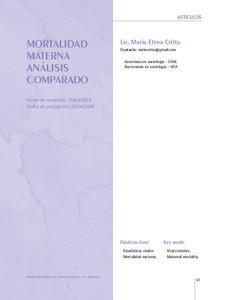Por favor, use este identificador para citar o enlazar este ítem:
https://repositorio.uca.edu.ar/handle/123456789/8843| Título: | Mortalidad materna : análisis comparado | Autor: | Critto, María Elena | Palabras clave: | BIOETICA; PROYECTOS DE LEY; ABORTO; MORTALIDAD; MATERNIDAD; ESTADISTICAS; POLITICAS PUBLICAS; ANALISIS COMPARATIVO | Fecha de publicación: | 2018 | Editorial: | Educa | Cita: | Critto, María Elena. Mortalidad materna : análisis comparado [en línea]. Vida y Ética, 19.1 (2018). Disponible en: https://repositorio.uca.edu.ar/handle/123456789/8843 | Resumen: | Resumen: La razón de la mortalidad materna
ha decrecido en un 22% en la
Argentina, en el periodo 2001-
2016. La muerte por embarazo
terminado en aborto fue la que
más se redujo en éste periodo,
con una disminución de un 56%,
es decir, más del doble que la
caída de la razón promedio. Las
principales causas de muerte
materna en Argentina refieren a
causas obstétricas directas e
indirectas. Las muertes maternas
por embarazo terminado en
aborto están en tercer lugar. Si
excluimos de este grupo a aquellas
especificadas como aborto
espontáneo, ectópico, o por
anormalidades de la concepción,
quedan 31 defunciones que
podrían incluir las muertes por
aborto clandestino y representan
el 12,65% del total de las muertes
maternas del 2016. Al comparar
los datos con los de Chile y
Uruguay observamos que
Argentina tiene una RMM con
más de 15 puntos sobre la de
cada uno éstos. Tanto Chile
como Uruguay han reducido significativamente
la razón de mortalidad
materna sin una ley de
aborto. La vigilancia epidemiológica de los datos sobre la salud
de las mujeres permite por un
lado promover aquellas políticas
que efectivamente han disminuido
la mortalidad materna, y
por otro, incentivar la inclusión,
la equidad, la salud y la educación
de todas las mujeres comprendiendo
el rol fundamental
que tienen para la familia y para
la sociedad. Abstract: In Argentina, maternal mortality ratio (MMR) has decreased 22% in the time period from 2001 to 2016. Among the causes of maternal mortality (MM), it was observed that pregnancies with abortive outcome (PAO) were reduced the most, reaching a lowering of 56%, i.e. doubling the reduction of the average rate. Direct and indirect obstetric causes are the two first causes of MM, followed by PAO. When drawing from the group of PAO such specific causes as spontaneous abortion, ectopic pregnancy, and other abnormal products of conception, it remains 31 deaths which could include clandestine abortion (CA). Average of CA represented 12.65% of total maternal deaths in 2016. Comparing statistical data from Chile, and Uruguay to Argentina’s numbers it is possible to observe that Argentinean MMR is 15 points higher of that from these two neighbor countries. Both Chile and Uruguay have reduced RMM in a relevant way without legalizing abortion. Epidemiological surveillance on women’s health leads us to promote effective policy for reducing MM, and increasing of inclusion, health care, equity, and education. All this actions should be performed with understanding of fundamental roll of the women for their families and whole society. |
Cobertura Espacial: | Argentina Uruguay Chile |
URI: | https://repositorio.uca.edu.ar/handle/123456789/8843 | ISSN: | 1515-6850 2683-6998 (online) |
Disciplina: | BIOETICA | Derechos: | Acceso abierto | Fuente: | Vida y Ética Año 19, N° 1, 2018 |
| Aparece en las colecciones: | VE - 2018 Año 19 nro. 1 |
Ficheros en este ítem:
| Fichero | Descripción | Tamaño | Formato | |
|---|---|---|---|---|
| mortalidad-materna-analisis-comparado.pdf | 832,33 kB | Adobe PDF |  Visualizar/Abrir |
Visualizaciones de página(s)
942
comprobado en 17-dic-2025
Descarga(s)
761
comprobado en 17-dic-2025
Google ScholarTM
Ver en Google Scholar
Este ítem está sujeto a una Licencia Creative Commons

